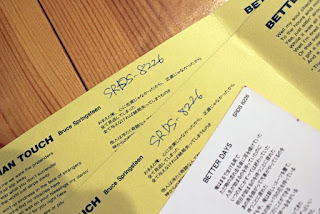Among 99 blog posts published before this one, the following are five of the most popular posts, according to the cumulative access number of visitors during the entire period starting from September 2014. The ranking results have revealed readers' view of what the general interests are.
- BORN TO RUN US pressing LP variants: the script cover (posted January 25, 2015)
- Classic Vinyl Bootleg Revisited: FIRE ON THE FINGERTIPS (posted October 24, 2014)
- Classic Vinyl Bootleg Revisited: THIS GUNS FOR HIRE 5LP box (posted April 23, 2016)
- Classic Vinyl Bootleg Revisited: TEARDROPS ON THE CITY 3LP (posted February 15, 2015)
- Classic Vinyl Bootleg Revisited: "E" TICKET (posted October 12, 2014)
 |
| The matrix number on Side A of the famous test pressing disc. Inset image shows the enlarged "P" stamp which is a definitive proof for Pitman pressing copies (also found on Side B). |
As already known widely, and shown here previously, P AL-33795 and P BL-33795 are the matrix numbers hand-etched on Side A and B, respectively, for the early US copies including the Script Cover pressing. These vinyl discs show variation in the suffix code that is either one of 1A, 1B or 1C, and there may be additional markings such as T1 and 1S on the dead wax space.
 |
| The matrix number on Side B of a white label promotional copy pressed at Pitman. Inset shows the enlarged "P" stamp which is also visible on Side A as shown in the above image of the test press. |
The suffix 1A is found in the matrix numbers for the famous Script Cover test pressing. This instantly means that "-1A" vinyl discs are pressed at the Pitman plant, because this pressing plant is mentioned on the white test-pressing labels (as "COLUMBIA RECORDS PITMAN, NEW JERSEY"; see here for the image). However, both promotional white and regular red COLUMBIA labels do not print any indications as to where a given disc was pressed. The direct proof for the Pitman-pressing copies for BORN TO RUN LP is a small letter "P" that is stamped on both sides of the deadwax. This letter is often so faintly stamped that one may not recognize it easily on these vinyl copies. It does nonetheless occur on the deadwax if a given disc truly originates as the first press from the factory located in the Garden State. Note that not all vinyl discs pressed at the Pitman plant carry the "P" stamp (it depends on in what year a disc was pressed). By the way, "P" in "P AL" and "P BL" has nothing to do with Pitman, but refers to regular popular releases (and corresponding white label copies) from this record label.
 | |
| The matrix number on Side A of a regular red-labeled copy that originates from the Terre Haute pressing plant, as indicated by the "T \" hand-etching. |
To my knowledge, the suffix 1B is always coupled with another hand-written mark "T1" or "T\", which precedes the matrix number on each side of the deadwax and refers to the Terre Haute pressing plant. I have white label promo and red label regular copies both of which show a combination of T1 and 1B hand-etched markings.
 |
| The matrix number on Side B of a white label promotional copy pressed at the Santa Maria factory, with the "1 S" handwriting. |
Finally, the suffix 1C comes with a scratchy handwriting "S1" that is backwards on the deadwax. As already mentioned here, this matrix etching specifies vinyl copies that were pressed at the Santa Maria plant. Although I have only white label copies for this West Coast pressing and don't own the regular copy, I am almost certain the association between "S1" and "1C".
Finally, the major aspects of matrix numbers for early US pressings of BORN TO RUN LP are summarized as follows (hand-etched, oblique; stamped, straight):
- Pitman P P AL-33795-1A MCRI / P P BL-33795-1A MCR
- Terre Haute T \ P AL-33795-1B MCRII / T \ P BL-33795-1B
- Santa Maria 1 S P AL-33795-1C MCRIII / 1 S P BL-33795-1C MCR










